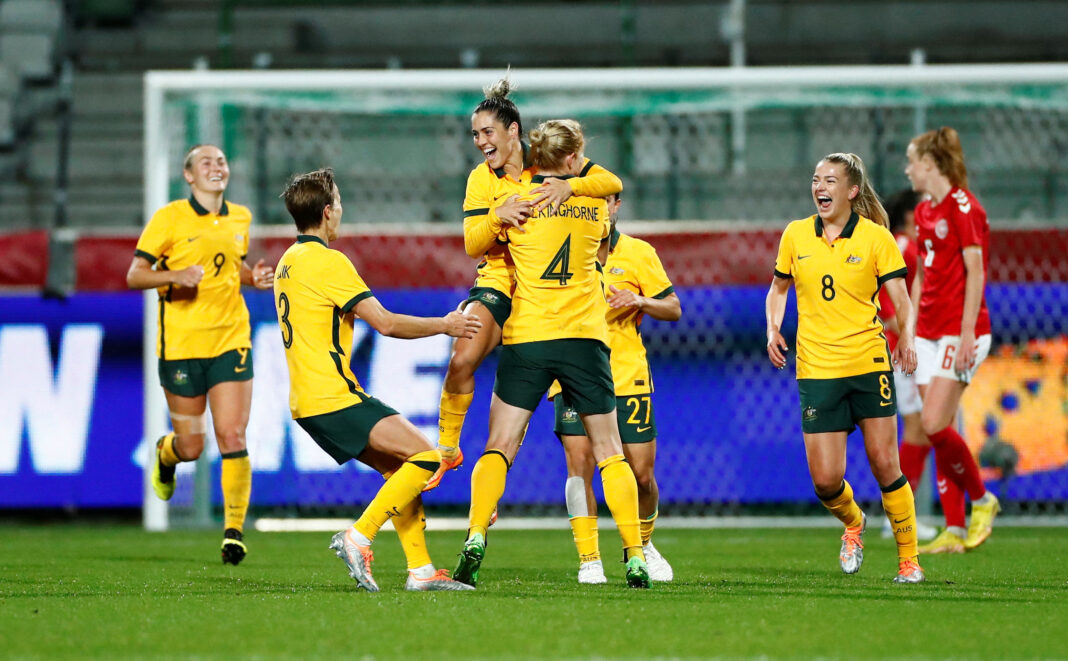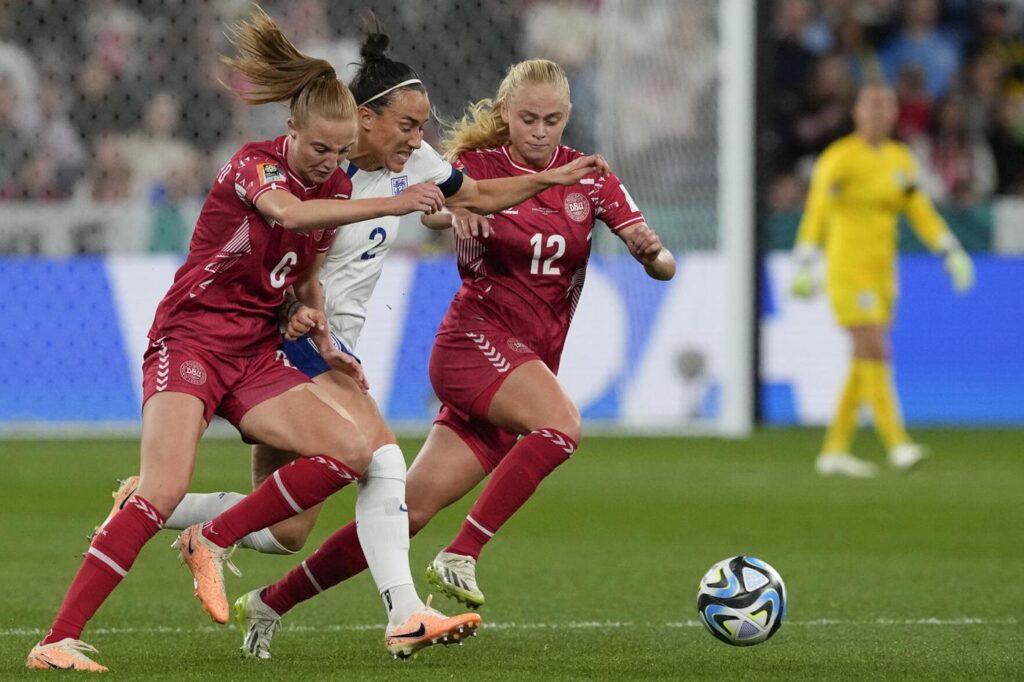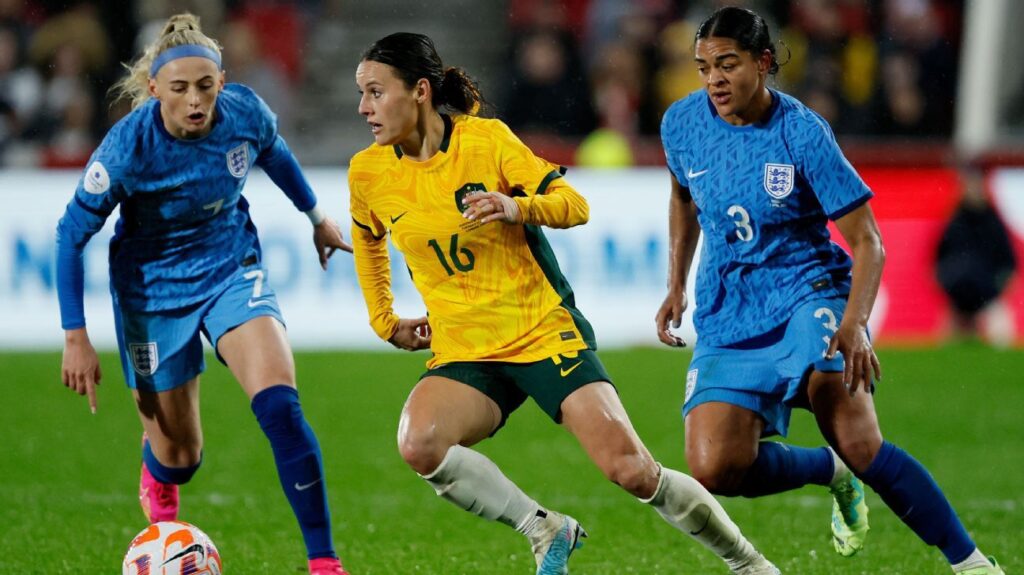

It’s amazing what a 4-0 win can do for a team’s perceived chances at a tournament; it was only last week that fans were calling for heads to roll in the Matildas camp, now many of those same fans are measuring players up for statues outside their respective home venues across the country.
For Denmark however, reaching the knockout stages at the Women’s World Cup signifies a massive shift in the country’s fortunes, having not progressed beyond their group since 1995. With several players at Europe’s top clubs, the Danes have every chance of causing the tournament co-hosts a real headache in Sydney / Wangal.
Last Time Out
Denmark 1 Australia 3 – Viborg, 2022
Conceding a first-minute goal to midfielder Karen Holmgaard, Australia looked destined to continue a 2022 of mixed results in central Denmark. However, three goals in 10 minutes – two to Caitlin Foord and the other to Katrina Gorry – saw the Matildas wrest back control from the Danes for their second consecutive win over European opposition.
Likely Starting XIs
 Given an extra week to recuperate her injured calf, Sam Kerr will likely re-take her position leading the line for Australia alongside Caitlin Foord. Having impressed against Canada, Mary Fowler may retain her place on the left flank ahead of Cortnee Vine, who would join Emily van Egmond on the substitutes’ bench.
Given an extra week to recuperate her injured calf, Sam Kerr will likely re-take her position leading the line for Australia alongside Caitlin Foord. Having impressed against Canada, Mary Fowler may retain her place on the left flank ahead of Cortnee Vine, who would join Emily van Egmond on the substitutes’ bench.
For Denmark, Kerr’s former Chelsea teammate Pernille Harder will again lead the attack in a 4-3-3, though her colleagues on either flank remain uncertain: Janni Thomsen has been preferred on the right wing by Lars Søndegaard, while his left-sided midfielder has been less consistent, juggling Rikke Marie Madsen and Nicoline Sørensen over the three group matches.
Three Key Battles
Harder vs Hunt & Kennedy
A three-time Champions League finalist and winner of seven consecutive domestic titles across Germany and England, Pernille Harder is undoubtedly among the all-time greats of Danish football. A prolific scorer for both club and country having racked up 345 goals in 494 senior appearances, Harder has for more than a decade been the focal point of Denmark’s attacking endeavours.


Knowing that Harder has only had 12 touches in the attacking penalty areas and managed just two shots on target, Australia have identified Harder as being an important part of the Danish attack, but not the be-all-and-end-all of their plans. Skilled at playing with her back to goal or dropping into midfield to include her wingers, Harder has acted as much as a false nine in this tournament as she has the point of Denmark’s attack.
That willingness to play deeper will likely cause headaches for Australia’s central defenders, forcing constant re-alignment should Harder move back and forth into a number 10 role, as they hope to alleviate an overload in midfield. With Harder just as quick of mind as she is of foot, Clare Hunt and Alanna Kennedy will have to be on their game to ensure the Danish captain remains as contained as they would hope.
The Middle Third
Having used a three-player central midfield throughout the majority of the group stage, Søndegaard will likely engage a 4-5-1 formation against the tournament co-hosts.in the hope of flooding the midfield and avoid being over-run when out of possession. Despite that numerical advantage, the Danes’ triad struggled against England, completing just 41 passes across the 90 minutes – two of which came from substitute Sanne Nielsen.


Focused around a double pivot of Karen Holmgaard and Josefine Hasbo, and playmaker Kathrine Møller Kühl, Denmark have most often opted to build up slowly from the back, content to look for space in which these midfielders can turn and play a pass to their respective wingers or Harder further up the pitch. That patient build up lead to Denmark averaging 34 completed passes per attempt on goal throughout the group stage – in contrast to England’s 37, Japan’s 24, and Australia’s 21 – highlighting the side’s cautious nature and willingness to control the tempo when allowed the opportunity.
Acting contrary to that control will be Australia’s midfield duo of Gorry and Kyra Cooney-Cross, who have shown – most notably against Canada – their ability to step into an opponent’s midfield triangle and either upset its rhythm or outright break up possession to regain ascendancy. Limited to only 59 passes between them in the final group stage match, Gorry and Cooney-Cross worked instead to diligently hound the Canadian midfield, crushing in around their opponents to ensure fewer than 35 passes made their way to the front third throughout the match. While Australia’s hopes won’t hinge entirely on the midfield duo winning every battle in the centre of the park, both sides will be keenly aware that any supremacy gained within that space will be crucial to the match’s outcome.
Denmark’s wingbacks vs Australia’s Counterattack
Denmark’s aforementioned wish to build up with slow and measured play, especially through a compacted midfield, leaves them at risk of a fast counter, and having struggled against counter-attacks during matches against both China and Haiti, Denmark will be keenly aware of both Australia’s pace on the wings and its midfielders’ ability to play passes through the lines in behind a defence in transition.


Having already shown their value to Australia’s attacking intentions, wingers Mary Fowler, Hayley Raso and Cortnee Vine will likely be called upon to accelerate the Matilda’s transitional play, hoping simultaneously to open an avenue to run in behind the Danes while also pinning their opponents’ fullbacks in the defensive line in order to avoid the same. Kept mainly in their respective pockets by England, defenders Rikke Sevecke and Katrine Veje were limited to only five lofted passes in the attacking half and totalled zero crosses into the penalty area, significantly hampering the Danes’ chances against a strong Lionesses side.
Australia will be keenly aware of this how this deficiency affected the outcome of that match, and though Lauren James’ early goal proved the difference, the Danes’ inability to fashion serious chances through their wide players may be of significant importance to the Matildas’ game plan as a whole. By stopping the wingbacks’ advancement through the threat of a deadly counter, Australia relieves itself of one defensive headache by potentially causing an even more serious one for its opponents.
Prediction
While Denmark kept things tight against England for 90+ minutes, the Rød-Hvide will need to press on to the Matildas in the hope of fashioning a result in regulation time. Having not come back from a deficit since 2022, the Danes will look to score early in order to force a result, but with Australia’s newfound verve after its win against Canada, they may find an opponent not willing to concede that advantage as hoped. Blessed with both pace and finesse in the final third, Australia will look to punish the Danes’ offensive adventures on the counter, and seek a path to the quarter-finals on home soil. Australia 2 Denmark 0













